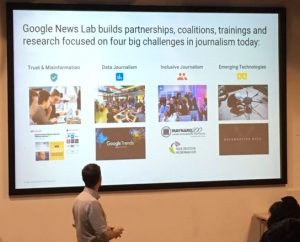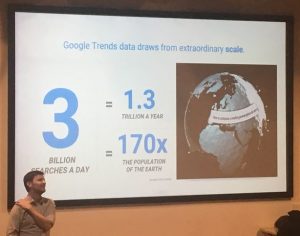Vincent Ryan presented this lecture on Friday 2nd November. It was organised by Miriam Phillips, Lecturer in Journalism and NCTJ Coordinator for the School of Journalism, English & Communication, and although primarily for Journalism students, spare tickets were offered to other staff and students. 
This is the second time the Google News Lab team (now Google News Initiative) has visited BU. Vincent gave a fascinating talk on some of the freely available technology tools to utilise when researching and producing news stories.
The session started with some practical research tips using Google’s advanced search techniques (for example, using the syntax ‘intitle: confidential’ to search for stories) and setting up Google alerts for current awareness, which now use AI (artificial intelligence) to identify unique stories and so avoid duplication. He also flagged Google Scholar their database of peer-reviewed articles.
In this era of fake news, Vincent talked about several resources which can be used to verify photos and videos on the web. With Tin eye you can upload an image or search by URL to see where images have been used online previously and how they might have been manipulated. SunCalc is an app that shows the position of the sun on any day at a given location and has been used to verify the authenticity of images. For videos, he recommended InVid which assesses the reliability of video files; crucial for verifying third party content of breaking news in this age of social media. Other tips were looking for the ‘verified’ tick on a YouTube video and using Amnesty International’s YouTube DataViewer to delve into the meta data behind a YouTube video.
Vincent talked about the importance of exploiting social media. For example, restricting a Twitter search to a geographical area to see what is being tweeted in the vicinity of breaking news. Another geographical tool is geosearchtool.com where you can search for videos posted from a specific location. Picodash will help you delve into Instagram to discover who is engaging with who; users who posted a particular hashtag or posted from a specific place, users who follow the same accounts (unfortunately this one comes with a one-off fee). Use Who.Is to find out the owners of domain names on the internet, or Wayback Machine the internet archive where you can go back in time to view historical snapshots of websites. And for a truly honest reflection of what people are searching for on the internet, try Google Trends. Most searched question in the UK in 2017? ’How to make slime’!
Google also has a dataset search to help researchers locate online data that is freely available to use, plus a public data search where you can view global statistics such as the World Development Indicators. Then create animated online charts and maps with your statistics using the templates provided by Flourish. Other visualisation tools demonstrated were Google maps, Google Earth Pro and My Maps where you can create your own map to embed into an article.
Vincent also discussed immersive environments, like the use of YouTube 360 via Google Cardboard and Story Spheres, a site where you can upload a 360 image and add audio to bring your panoramic image to life (remembering that 360 cameras are available to borrow from the FMC store!).
 He gave a very engaging talk packed with ideas and examples, and lots of ideas to take away. And still to come is Google Fact Checker which will be launching after Christmas. It is hoped that Vincent will become a regular speaker visiting on a yearly basis to give Google’s latest updates.
He gave a very engaging talk packed with ideas and examples, and lots of ideas to take away. And still to come is Google Fact Checker which will be launching after Christmas. It is hoped that Vincent will become a regular speaker visiting on a yearly basis to give Google’s latest updates.
Further links:
First draft – using research-based methods to fight mis- and disinformation online
International Fact-Checking Network
Journalism 360 – promoting immersive storytelling in the news
Product hunt – discover the latest tech tools being launched







